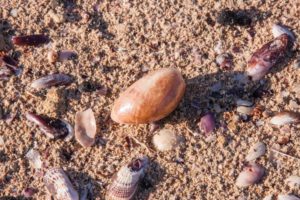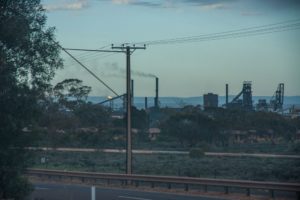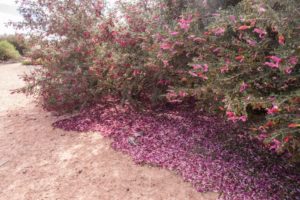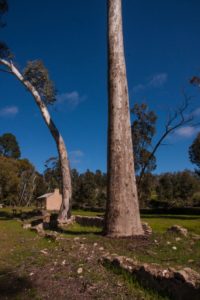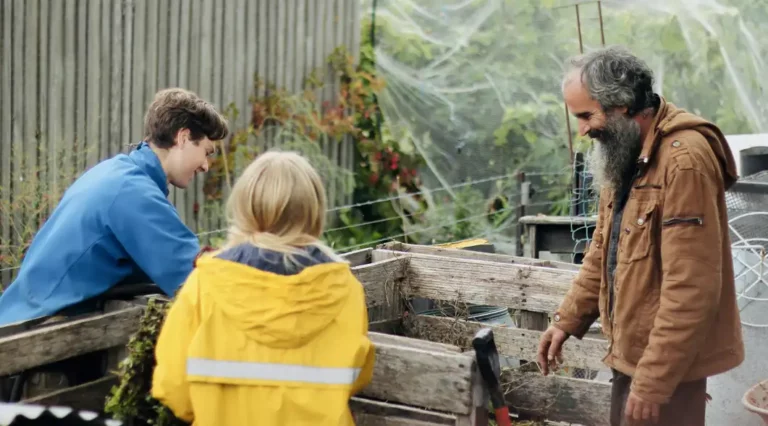The Ceduna A1 Cabins and Caravan Park was more downmarket than Esperance, and cost $18 and a friendly rave about the “bloody banks” from the proprietor. We were greeted by our neighbour, one of the elderly permanent residents, availed ourselves of hot showers and a most pleasant dinner by a permitted campfire listening to junkyard blues on Su’s iPhone. The junkyard blues became real by morning with the noise of two refrigerated shipping containers turning on and off, and the night shift at what turned out to be the local bakery across the fence.
With the young Punjabi mechanic at Ceduna Motors set to do the job (assuming the right bearings were available in town) we headed for the Blue Dolphin cafe to have our first purchased breakfast of the trip and catch up with communications, photo download and writing. As we suspected the axle had suffered damage but not serious. We couldn’t believe how lucky we had been for it to happen in town – or just maybe we had been ignoring more subtle signs of problems for much longer. While the mechanic completed the rebuild we cruised around the bay, checked out Port Thevenard where 2 million tons of gypsum, 0.5 million tonnes of mineral sands, 100,000 tonnes of salt and 400,000 tonnes of grain, mostly wheat, are shipped out. The ship-loading wharf was in the process of being rebuilt over two years while it remained in operation. From our viewing point we could see the workers using high pressure water guns to break apart the old structure weakened by concrete cancer.

Bulldozer working the salt stockpile at Port Thevenard
With the time spent by the mechanic taking every care and explaining all the issues, we were a bit worried about the likely cost, but were happy in the end with both the service and the bill. We had a plan to get back to Fitzgerald Bay the next day for a couple of nights, hopefully with another rendezvous with Jonathon Dobson to return gear and books and share an evening meal. We also expected to have discussions about Australia ecological history in light of the book Jonathon leant us during our previous get together. Aboriginal Environmental Impacts by James Kohen gives a broad overview of the archaeological, historical and ethnographic evidence, and provides an excellent base to discuss the more radical interpretations that have followed from the renewed focus on historical records provided Bill Gamage and even more dramatically by Bruce Pascoe.
We headed south looking for campsites in the same general area we had camped 20 years before. Thunilppi Rd took us to the Venus Bay foreshore. Our chosen camp on a sliver of brown loam soil over limestone sheet rock was sheltered by Mallee eucalypts with abundant firewood and a pile of limestone rocks indicating previous campers. This stretch of ground was obviously old sheep pasture but being part of the Venus Bay Conservation Reserve it had a soft look about it, more like the indigenous managed landscapes of the early paintings than the modern wilderness thicket vegetation that is so typical of conservation areas. As soon as Su got out of the car she was accosted by clouds of mosquitos, providing a decoy for David for the short time it took to get the firepit organised and fire going, to which we added green bridal creeper to create smoke. A few spots of rain, minimal wind complemented a dinner of fresh whiting filets (from the Port Thevenard fish processors) and cooked vegies from the night before.
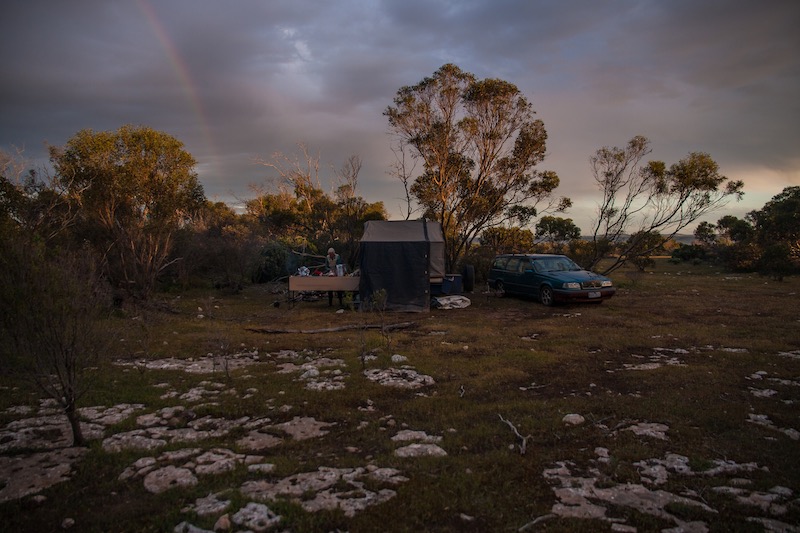
Campsite by Venus Bay
In the morning we walked the Venus Bay foreshore, which is formed from banks of shell grit. Su’s thoughts of her chookie girls at home had us collect about 20kgs in a plastic bag with our camp dustpan as a scoop. A brief stop in Port Kenny to collect ripe quandongs from roadside shrubs and a view over Waterloo Bay from Salmon Point was all we managed with a full days drive to Fitzgerald Bay via Port Lincoln. Once we remembered the need to be somewhere with phone service for our home office Zoom meeting, we decided to truncate our coastal cruise and head to Tumby Bay where phone service was much better. The journey took us through Cummins in the heart of the higher rainfall cropping country of the lower Eyre Peninsula. Bright green paddocks of wheat, barley and fava legumes alternated with blinding yellow canola. Cummins has all the signs of big ag enterprise and infrastructure but no silo art. Out of town the continuous cropping country of big paddocks and few trees changed to the grazed hills of the Copin Pass with the bendy local provenance of Sugar Gums, often planted in Victoria for their bushy habit.
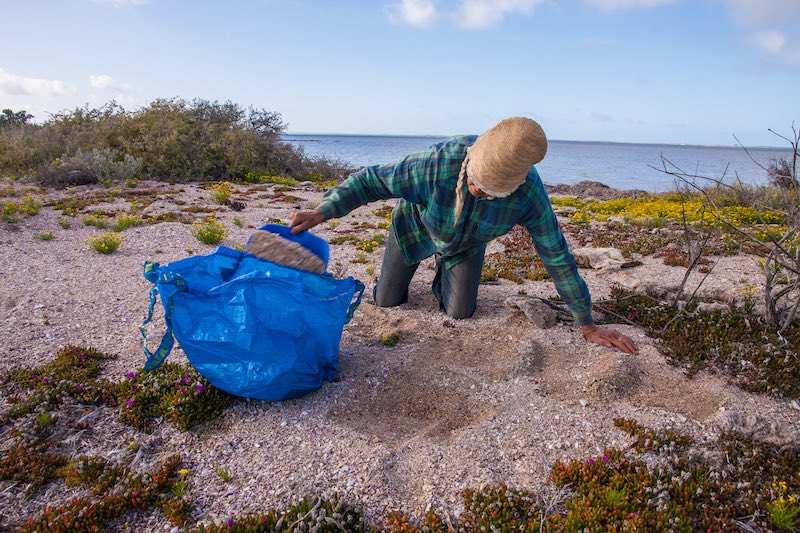
Su collecting shellgrit at Venus Bay, a modest harvest limited by our ability to carry the bag from foreshore to the car on the track
We arrived at Tumby Bay on the dry side of the peninsula back into coastal tourist land (with silo art) in time for lunch in the car with a strong offshore wind outside. After our Zoom connect with those keeping the Holmgren Design and RetroSuburbia show on the road and other email correspondence and we headed north up the Lincoln highway towards Whyalla and Fitzgerald Bay. The green crops were fewer, shorter and just starting to dry off as we moved to the margins of the grain belt north of Cowell.
Su was happy to get back into the grey saltbush and trees of the arid zone while David continued to marvel at the scale of cropping of a few annuals that feed the multitudes (and their livestock) here and abroad. Even though arable (cropping) land is only a few percent of the continent, the vast scale of that cropping relative to the dense urban centres that directly and indirectly consume most of yield cannot be grasped by simply reading numbers on a page. As we drove towards Whyalla we could see the York Peninsular (more cropping country) across the water of Spencer Gulf to the east, to the west alluring “Jesus” light broke through dark clouds promising rain, at least further south, and to the north the great line of the Flinders Ranges framed the vast landscape.
The unoccupied nook at Fitzgerald Bay gave some sense of the emotions of homecoming that had been growing in us for the last week. The setup at dusk was quick, almost automatic.
Friday was a day of strong wind but our sheltered nook was perfect for domestic catch up as the driving southerly pushed the tide in the upper Spencer Gulf to a higher level that we had experienced.
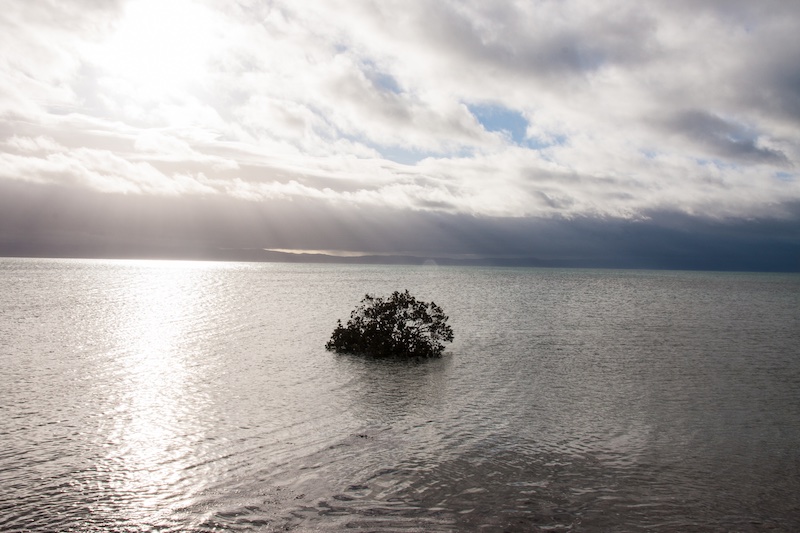
Fitzgerald Bay Lone mangrove at wind driven high tide with cloud on Southern Flinders across Spencer Gulf on the horizon
Saturday morning we said goodbye to Fitzgerald Bay with a plan to get to O’Reilly’s Orchard in Wirrabara for a dinner and evening with Jacky, Dave and some of their friends. The drive being only three hours gave us time to visit the Arid Lands Botanic Gardens in Port Augusta, where the spectacular diversity of Eremophila species from all over arid and semi-arid Australia were a highlight.
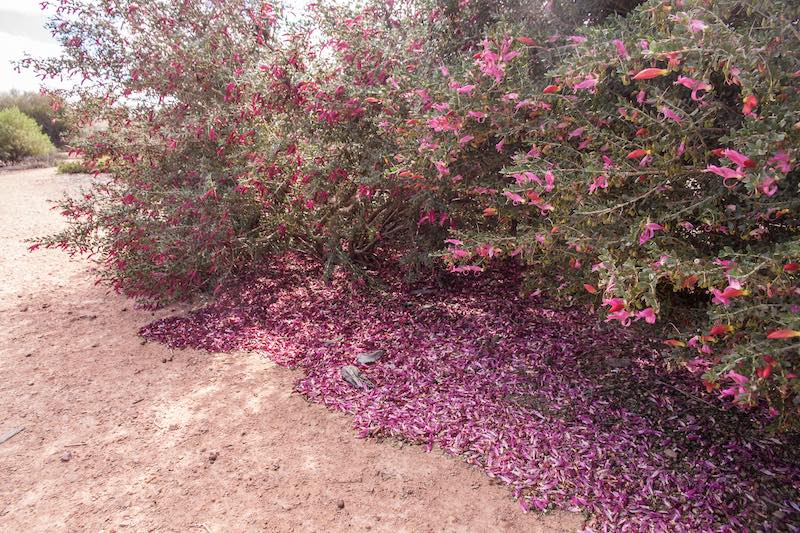
Peak Eremophila blossom carpeting the ground at the Arid Lands Botanic Gardens
Our second drive through Telowie Gorge was an opportunity to stop and photograph recovering vegetation and lost old growth trees after the great fires of 2016, as well as rock formations and stone walling. A slow drive from Wirrabara took us to the King Tree Paddock, a reserve around a still living massive Red Gum of the impressive local provenance that grows tall and straight, a rarity for most provenances of Red Gum across the huge swath of Australia where they are native.
Arriving at O’Reilly’s Orchard, Jackie was in the kitchen preparing what proved to be more of a banquet than dinner. The few friends included Colin Ball and Ulrike two of the early Adelaidian permaculture activists who both now live and work in the region. Colin regaled us with the history of urban conservation activism in working class Bowden Brompton that included a permaculture inspired city farm that ran for a number of years in the 1980s. He is now working on lodging of archives of the project with the National Library and gave David a memory stick of the archives. The weight of history! Also present were other local small producers and, a late arrival after her rounds, Helen, a local community GP with a passion for rural generalist medicine (and her donkeys). Discussions continued to midnight which was probably too late for David O’Reilly who had to get up for a farmers market in the morning.
We left with a deeper appreciation for men, and especially women, of our own generation with vision, passion and persistence creating the world we yearn for, despite the tides of societal delusion and dysfunction we have lived through.

Stone fruit blossom at O’Reilly’s Orchard
The instruction from Jackie to visit the old forestry nursery and arboretum, being recovered after partial devastation in the fires was unnecessary. Old gardens and forest arboreta especially those neglected, abandoned or impacted by natural forces had been a source of inspiration for David since his research towards Permaculture One in the mid 1970s. This one also provided insights, especially the unburnt grove of elm, poplar and ash that had colonised the major spring just below the arboretum on Ippinitichie Creek. It provided strong parallels to the Spring Ck novel ecosystem that we have been husbanding for decades next to our home patch. Another exciting confirmation was the fire-resistant character of Pinus canariensis, the species of conifer permaculture colleague Graham Brookman had chosen to plant for heirloom timber at the Food Forest on the dry north Adelaide plain, our next destination.

Naturalised Canary Island Pine (from mature trees in background) showing epicormic regeneration after intense bushfire that killed all the surrounding Radiata Pines
The journey south to the Food Forest took us through some of the best of the “inside” grain bowl of SA where wheat, barley, and fava crops covered most of the landscape in a verdant green alternating with stunning yellow fence-high canola, but the towns showed a marginal dependence on passing traffic. As the hills of the southern Flinders softened into those of the mid-north, the shift into the Clare Valley was not only one of more intensive and diverse landuse but also more vibrant economy sustained by the capital city and globalised affluence drinking the famous wines and savouring the regional food. Around farmhouses, along roadsides and along creeks, the local blend of native and naturalised vegetation including signature cherry plum, olive and ash trees was creating novel ecosystems of great vigour.
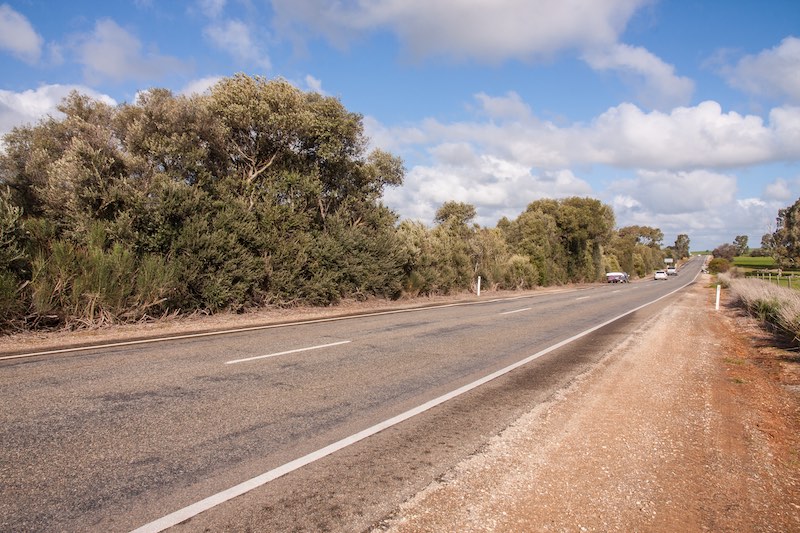
Thick naturalised olive vegetation fringing the highway south of Clare, some still carrying fruit from the previous season
At Tarlee we noted the Four Leaf Mill, a well know organic brand started by organic pioneer Gavin Dunn. Jackie had suggested we could call in on Gavin and Rosemary who were her mentors in organics when she was in her 20s. It would have been good to pay our respects to organic pioneers almost a generation our elders but time and lack of prior planning had us moving on through more broadacre non-organic acres of the Lower North before we hit Gawler, the gateway to another iconic agricultural valley, the Barossa. A few kms on the highway bypass, an overshot exit and a few extra kms took us to our haven at the Food Forest between the Gawler bypass, new housing developments and the intensive horticulture of the north Adelaide plain dependent on depleting groundwater and treated sewerage water.
<< Previous Chapter — — — Next Chapter >>










